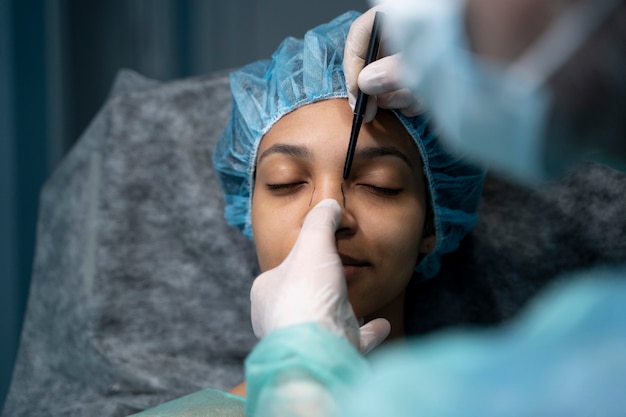Pushpanjali Eye Care, Golpark, Kolkata-700029
Pushpanjali Eye Care, Golpark, Kolkata-700029

By PushpanjaliEyeCare
28.05.2024
Hello Reader!
Welcome to the blog page of Pushpanjali Eye Care, one of the best eye hospitals in Kolkata.
Glaucoma is a group of eye conditions that can cause blindness if left untreated. It is a progressive disease that damages the optic nerve, which is vital for good vision. Understanding the age-related risks, treatment options, and preventive measures for glaucoma is crucial for maintaining eye health. At Pushpanjali Eye Care, the best eye hospital in Kolkata, we provide comprehensive care and treatment for glaucoma, helping our patients manage this condition effectively.

Glaucoma is often associated with aging, and the risk of developing the condition increases significantly with age. While it can occur at any age, including in infants and young adults, it is most commonly diagnosed in people over the age of 40. The likelihood of developing glaucoma increases with each decade of life, particularly after the age of 60. Regular eye examinations become increasingly important as you age, especially if you have a family history of glaucoma or other risk factors such as diabetes, high blood pressure, or nearsightedness.
While glaucoma cannot be cured, it is treatable, and early detection is crucial in preventing severe vision loss. The primary objective of glaucoma treatment is to lower the intraocular pressure (IOP), thereby preventing further damage to the optic nerve. Various treatment options are available to manage and control glaucoma effectively, each tailored to the specific needs and conditions of the patient.

Prescription eye drops are often the first line of treatment for glaucoma. These medications work by either decreasing the production of aqueous humor (the fluid in the eye) or by improving its outflow, thereby reducing the intraocular pressure. There are different types of eye drops available, including prostaglandin analogs, beta-blockers, alpha agonists, and carbonic anhydrase inhibitors. Each type works differently, and your ophthalmologist will prescribe the one that is most suitable for your condition. Consistent use of these medications as prescribed is vital for their effectiveness.
Laser surgery is another effective method to treat glaucoma, particularly when medications alone do not suffice. Laser procedures help improve the drainage of fluid within the eye, thereby reducing intraocular pressure. Common laser treatments for glaucoma include:

When medications and laser treatments are not sufficient to control glaucoma, surgical options may be necessary. Surgical procedures aim to create new drainage channels for the aqueous humor to reduce intraocular pressure effectively. Some common surgical treatments include:
At Pushpanjali Eye Care, the best eye hospital in Kolkata, our experienced ophthalmologists utilize the latest technologies and treatment methods to manage glaucoma effectively. We are committed to providing personalized patient care, ensuring that each patient receives the most suitable and effective treatment for their specific condition. Our comprehensive approach to glaucoma care aims to preserve vision and improve the quality of life for our patients.
Preventive measures play a vital role in managing and restricting the progression of glaucoma. Here are some essential steps to take:
Glaucoma is most commonly diagnosed in individuals over the age of 40, with the risk increasing significantly as one gets older. While it can affect people of any age, including infants and young adults, the likelihood of developing glaucoma rises notably after the age of 60. Regular eye examinations are crucial for early detection, especially for those with risk factors or a family history of glaucoma.
While glaucoma cannot be cured, it is treatable, and early detection is vital for preventing severe vision loss. The primary goal of treatment is to lower intraocular pressure (IOP) to prevent further damage to the optic nerve. Treatment options include prescription eye drops, laser surgery, and conventional surgical procedures. These treatments aim to either reduce the production of fluid in the eye or improve its drainage, thereby lowering eye pressure and protecting vision.
*Several lifestyle changes can help manage and restrict the progression of glaucoma:
For individuals over the age of 40 or those with risk factors such as a family history of glaucoma, it is recommended to have a comprehensive eye examination every one to two years. People over the age of 60 should have annual eye exams. Regular check-ups allow for early detection and timely intervention, which are essential for managing glaucoma effectively.
Several risk factors can increase the likelihood of developing glaucoma, including:
Glaucoma is a serious eye condition that requires ongoing management and care. While it can affect individuals at any age, the risk increases with age, particularly after 40. Early detection through regular eye examinations and prompt treatment can help manage the condition effectively and prevent significant vision loss. At Pushpanjali Eye Care, the best eye hospital in Kolkata, we offer comprehensive glaucoma care and treatment tailored to each patient’s needs. By taking preventive measures and adhering to treatment plans, individuals can restrict the progression of glaucoma and maintain their vision health.
For more information or to schedule an eye examination, visit Pushpanjali Eye Care, your trusted eye hospital in Kolkata. Our team of experienced ophthalmologists is dedicated to providing the highest quality of care to ensure your eyes stay healthy and your vision remains clear.